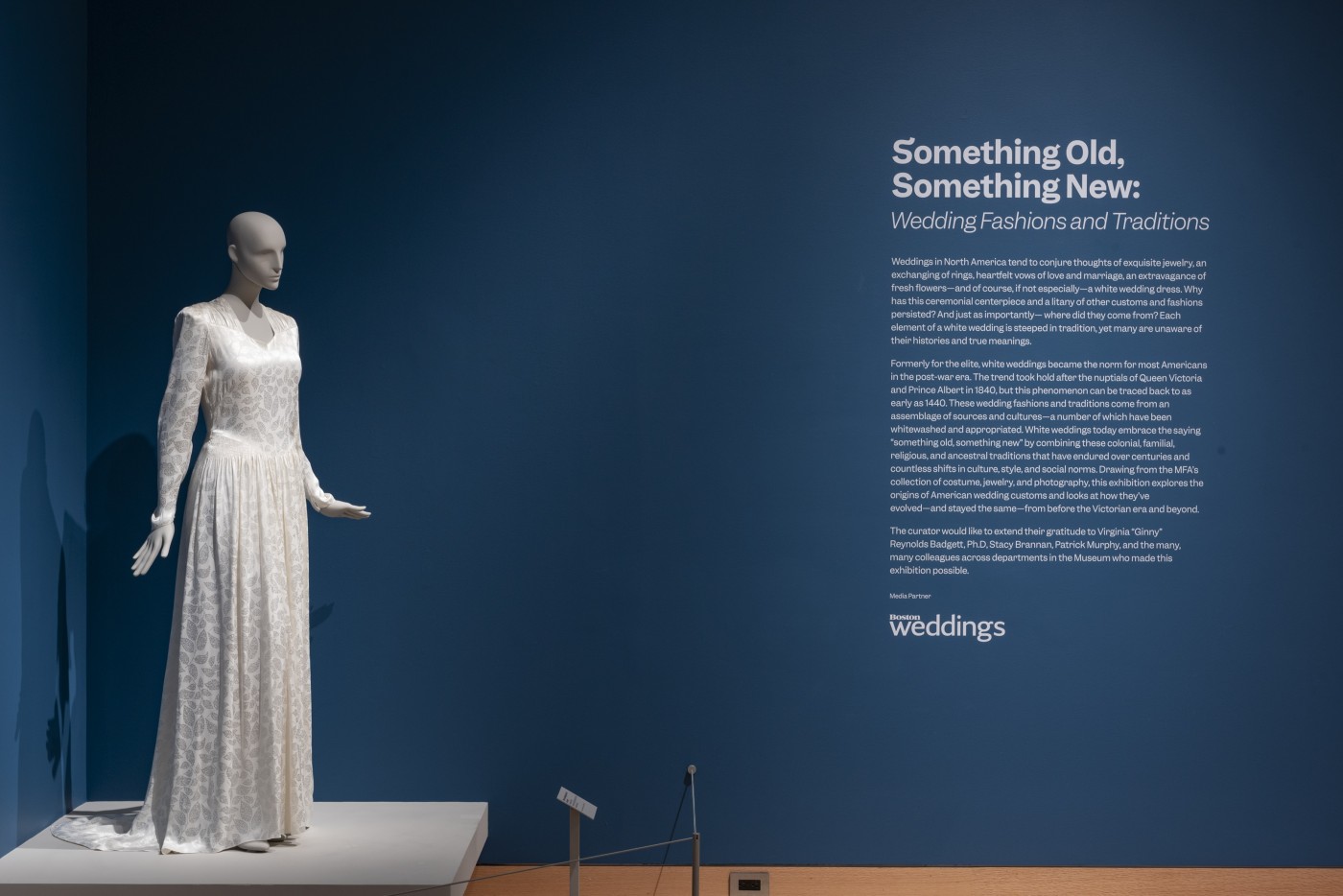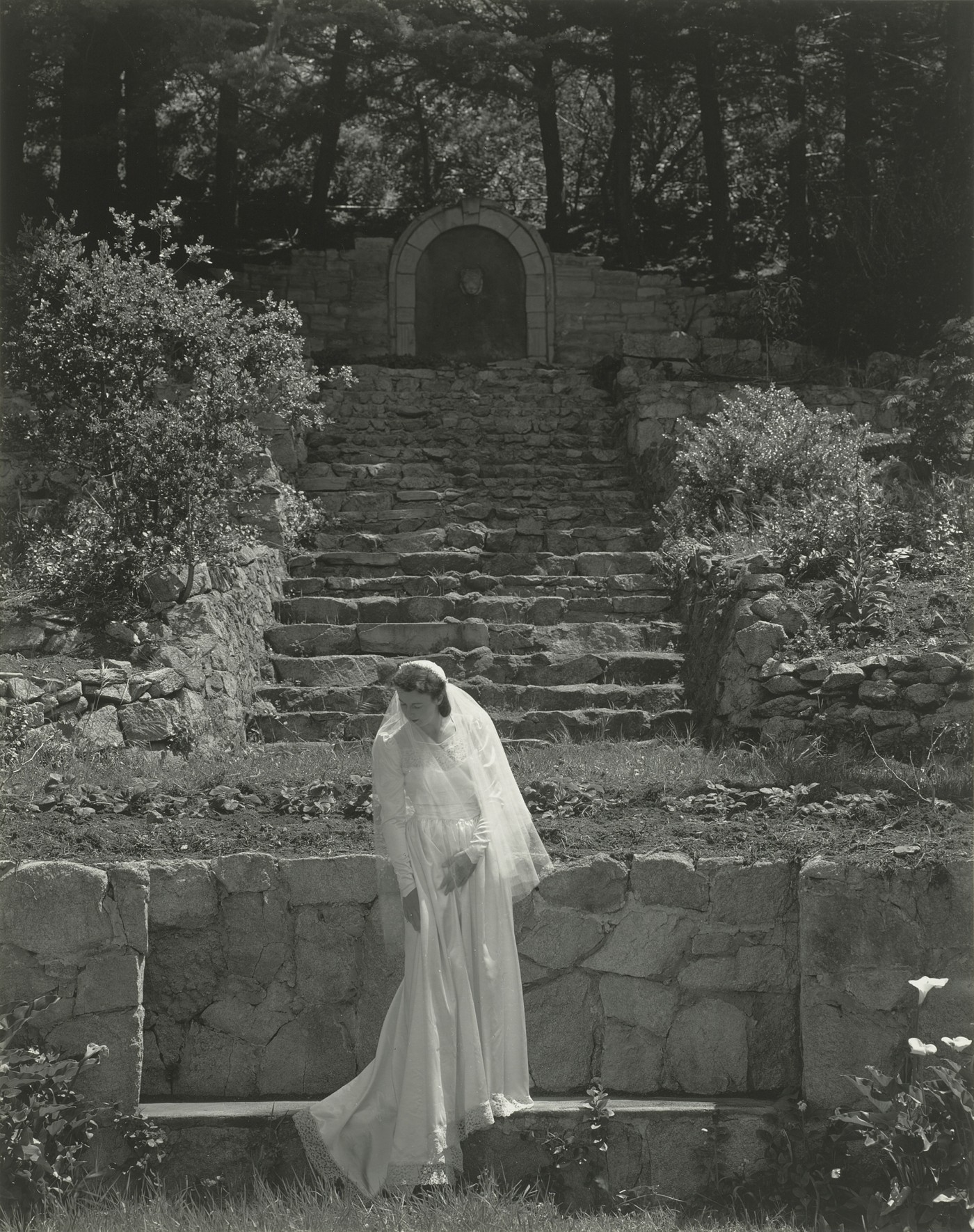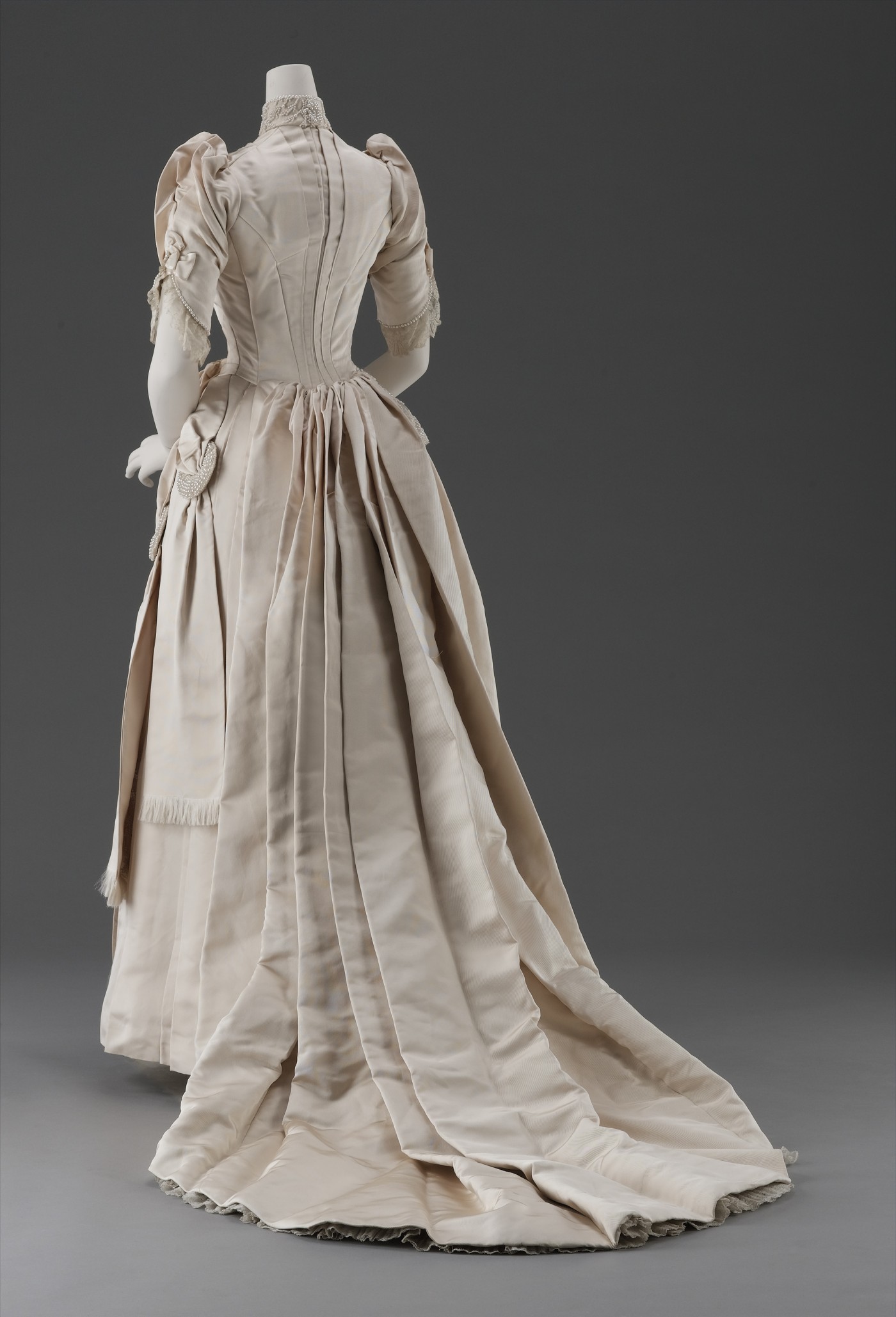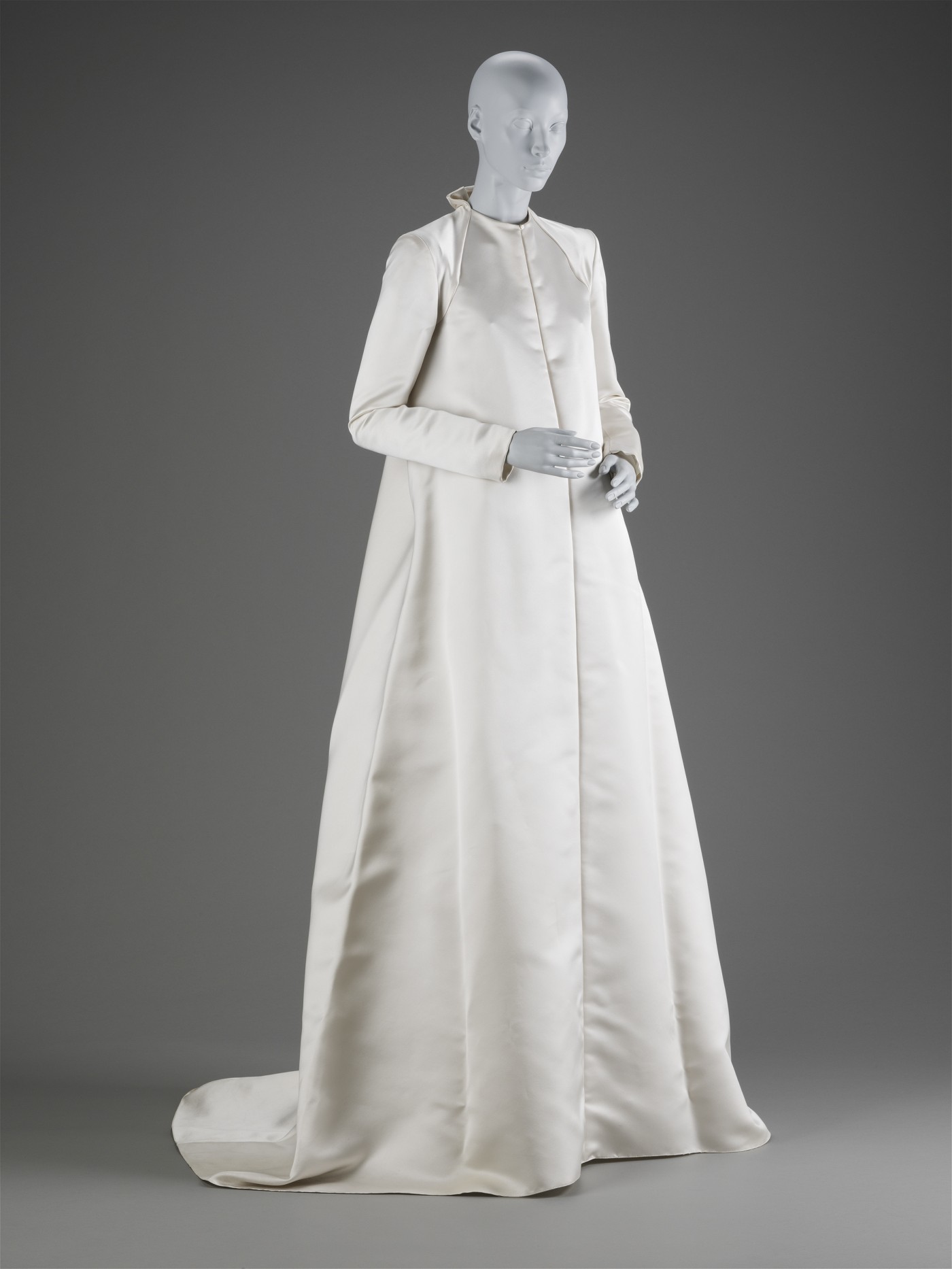- youtube
- bluesky
- Home
- About
- Costume Journal
- Membership
- Conference & Events
- Grants & Awards
- News & Social
In this week’s blog, News Editor Babette Radclyffe-Thomas reviews the Museum of Fine Arts (MFA) Boston’s wedding themed exhibition.
‘Something Old, Something New’ the adage goes, but how many of us really know the origins of classic wedding customs and traditions? White silk dresses, diamond rings and orange blossom wreaths have been a staple of North American weddings since the 19th century, and so a new exhibition in Boston at the MFA explores these enduring wedding traditions.
“Formerly for the elite, white weddings became the norm for most Americans in the post-war era. The trend took hold after the nuptials of Queen Victoria and Prince Albert in 1840, but this phenomenon can be traced back to as early as 1140. These wedding fashion and traditions come from an assemblage of sources and cultures – a number of which have been whitewashed and appropriated. White weddings today embrace the saying ‘something old, something new’ by combining these colonial, familial, religious and ancestral traditions that have endured over centuries and countless shifts in culture, style, and social norms,” the exhibition introduction states.
The exhibition is curated by Theo Tyson, Penny Vinik Curator of Fashion Arts, a position responsible for developing the MFA’s collection of 20th- and 21st-century fashion. Following 20 years of entrepreneurial and corporate experience in the fashion industry, Tyson held positions as a project manager at the Spelman College Museum of Fine Art and as a stylist and researcher at the SCAD FASH Museum of Fashion + Film, where she worked on the 2018 exhibitions Pierre Cardin: Pursuit of the Future and Guo Pei: Couture Beyond. She curated the exhibition (Anti)SUFFRAGE (2019) during her fellowship at the Boston Athenæum while she served as the Polly Thayer Starr Fellow in American Art and Culture. Tyson joined the MFA in 2022, and her vision for the fashion collection prioritizes inclusion, community and relevancy which is clear to see in this wedding-themed exhibition, and she recommends acquisitions that strengthen and diversify the MFA’s holdings.
In 1930, the MFA established the first textile arts department in an American museum. Today, the collection is global in scope, encompassing more than 30,000 objects that range from ancient Egyptian pleated dresses to contemporary haute couture and ready-to-wear garments.
The museum does not have a dedicated fashion gallery, and the exhibition is instead in the Americas wing. Fashion garments and accessories appear in different spaces and galleries throughout the museum which allows Tyson to introduce interventions and consider how to bridge the gap between collections. When planning for this exhibition, Tyson had unexpected music inspiration.
“I stood in the empty exhibition space and looked around and felt surrounded by this white cis gender heteronormative patriarchal identity. Then Billy Idol’s White Wedding song popped into my head, and it played on a loop in my head until I looked through our database for wedding themed items and from there the idea for the exhibition kept taking form”.
Nearly 40 objects from the museum’s fashion collection are displayed, including dresses, shoes, jewellery, undergarments, and hair accessories. The exhibition is thematically grouped and covers several centuries showcases the evolving and lasting trends of wedding fashions, customs and traditions. There are seven wedding dresses on show including stunning dresses designed by Arnold Scaasi and Priscilla Comins Kidder which form the centrepiece of the exhibition and are a treat for visitors keen to see more of North American fashion.
There is a sleek modern white silk satin trapeze gown by Geoffrey Beene which is also Tyson’s personal favourite dress due to its timeless appeal and luxurious sensibility. Beane was an American couture designer with clients including Faye Dunaway and Nancy Reagan. The Scaasi dress is a very different mood and is one from the MFA’s substantial collection of his works and one of his most iconic looks. Scaasi was renown for using exotic feathers, fur, sequins, crystals and the finest embroidery, which is shown with this 1989 dress.
“One of my favourite pieces is the Bob Mackie dress. It’s pink. It’s Bob Mackie. I could have stood on that platform smoothing each of the pearls for hours! I love the drama of it”, Tyson shares.
This Bob Mackie design is a woman’s bridal ensemble from the 1980s, a gift of local Boston entrepreneur Yolanda Cellucci and is a light pink silk with a layer of white tulle adorned by countless white faux pearls sewn to create a floral pattern.
Despite being in just one room, the depth and detail of the exhibition is impressive. Drawing from tens of thousands of items from across the museum’s expansive collections, Tyson has presented a very edited selection. The space limitations aided the selection of pieces, for example Tyson had over 100 white wedding themed fans to choose from. “Sometimes the object lets you know. I wanted to make sure visitors could meet the piece at eye level, rather than looking down upon it, as well as ensure the safety of the presenting the object, so that helped make the decision for me too. The space made the decision for me.”
The exhibition includes sections on memorable moments, beneath the gown, gold, diamonds & pearls, the wedding dress and orange blossoms. The exhibition sees the collaboration of a wide range of departments across the museum. “I never want to walk into a gallery and just see mannequins. There will always be photography for example…One of the reasons I like my title of curator of Fashion Arts is that I am taking these concepts of fashion and art that are traditionally presented separately, and I am now pushing it to the limit of who I can engage and how,” Tyson shares. The surrounding walls showcase a wide range of material culture including striking jewellery cases. Here visitors can see a gold wedding band made in the 18th century made by Paul Revere and a delicate turquoise-and-pearl brooch designed by Prince Consort Albert for Queen Victoria’s bridesmaids on their 1840 wedding.
A wall of wedding photographs includes formal portraits taken by well-known photographers such as Cecil Beaton and Henri Cartier-Bresson, but also includes images of candid snapshots by unidentified photographers. At first sight, the photo selection feels very familiar and accompanied with the exhibition themed soundtrack gives a cozy homely feel.
“The photo wall is meant to mimic your mum or auntie’s living room wall and see all of your favourite life moments, and make visitors feel like they are at home. When I acquire pieces, I am considering how acquisitions can benefit other collections for example fashion photography may help expand the photography collection. The use of photography begs the question who weddings are for, and what they are for. Historically essentially, they were business transactions….In our collections, representations of couples in wedding photos have been very similar and there is often a lack of diversity, so I laid the photos out in this exhibition in a way that your sightline went to the people of colour first, so the stars of photography for example Horst were placed at the bottom.”
“I have three tenants in my work: it must be meaningful, useful, and joyful. This can apply to anything. For example, the 1889 historical wedding dress has a 19-inch waist which is very disproportionate to her hips and bustle. Everything in the bodice is fully padded out, and then we realised after analysing her proportions that she was probably a child bride.”
“Something that is very important to me as a curator and a human, is humanity and accessibility. We worked with our Director of Accessibility, and I went a step further in the installation by taking two different style wheelchairs and moved them through the space to look for pinch points.”
Tyson has an experiential events background, which comes through especially in the choice of wedding music throughout the exhibition. The playlist includes classics such as Etta James At Last, Whitney Houston’s I wanna dance with somebody and Billy Idol’s White Wedding.
“Music in exhibitions makes it more approachable and accessible,” Tyson shares. The spirit of collaboration which is at the heart of Tyson’s curatorial approach is clear to see in the exhibition. During the exhibition planning process, one of the MFA’s curators of Prints and Drawings Patrick Murphy upon hearing of Tyson’s upcoming wedding exhibition, let her know that he owned a limited edition white vinyl copy of Billy Idol’s White Wedding and asked if she would like to include it in the exhibition. “It was clearly very personal to him and he even opened it for the exhibition. That generosity and spirit of collaboration, I love being able to work with such amazing talented human beings.”
Tyson shares that the exhibition had a short turnaround of only six months, in contrast to other exhibitions that are worked on years in advance, and so far the exhibition has been very well received so far. “I have a tendency to hide in the exhibition in plain sight just so I can hear natural and organic comments from visitors and to see what they are responding to. It is nice to see people in the exhibition, museums should be living institutions not relics of the past…I took a group of wedding vendors on a tour of the exhibition and 95% of them did not know the origins of these traditions, and that’s when I think I have done my job well.”
“One of the things I love about curating fashion is that fashion can be so innocuous, everyone can engage with it…I never want to tell people what to think, I just want to encourage them to do so. My goal is to make people think and feel. I really like the concept of story sharing”. This is echoed in the captions for each section that include prompts in bold font, so visitors are encouraged to reflect upon their own wedding experiences, such as “What is your most memorable wedding moment? Did you capture it through photography?”
Tyson is already busy working on an exciting upcoming exhibition, 'Dress Up'. This exhibition will be a celebration of adornment and the interlinked relationship between fashion and jewellery. Due to open April 13 2024 and running to September 2 2024 and will surely be one to see.
The exhibition is on view May 27 through October 1, 2023.
To see Babette's last museum review, visit her recent blog post.
Image gallery

Something Old, Something New: Wedding Fashions and Traditions exhibition at the Museum of Fine Arts, Boston. May 27 to October 1, 2023. Edward and Nancy Roberts Family Gallery. Photograph © Museum of Fine Arts, Boston

(Wedding portrait), 1947 (?) Edward Weston (American, 1886–1958) Photograph, gelatin silver print. The Lane Collection. Courtesy Museum of Fine Arts, Boston

Wedding dress, 1889 Silk plain weave (faille), net and machine lace, embroidered with pearl beads. Gift of Mr. Henry S. Hall, Jr. Photograph © Museum of Fine Arts, Boston

Wedding dress, spring 2002 Geoffrey Beene (American, 1927–2004) Double‐faced silk satin. Gift of Mr. Geoffrey Beene. Reproduced with permission. Photograph © Museum of Fine Arts, Boston